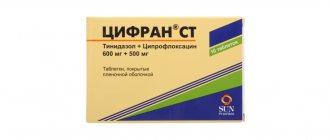pharmachologic effect
The substance is a combination of an antibiotic and mucolytic drug.
Thiamphenicol has a wide spectrum of action on bacteria that cause respiratory tract infections - both gram-positive (streptococci, clostridia, staphylococci) and gram-negative (neisseria, Haemophilus influenzae, salmonella, yersinia, E. coli).
Acetylcysteine actively dilutes sputum and purulent discharge, promotes sputum discharge, reducing viscosity.
Acetylcysteine promotes better penetration of thiamphenicol into the lung tissue and prevents the adhesion of microorganisms to the mucous membrane of the respiratory system.
Indications for use
- damage to the ENT organs and upper respiratory tract ( sinusitis , otitis , laryngotracheitis );
- diseases of the lower respiratory system ( bronchitis , lung abscess , pneumonia , bronchiectasis, cystic fibrosis, emphysema , whooping cough , bronchiolitis );
- treatment and prevention of infectious and obstructive complications after tracheostomy, thoracic surgery (atelectasis, bronchopneumonia );
- preparation for aspiration of bronchial secretions and bronchoscopy;
- in order to improve drainage in case of concomitant pulmonary infections (including tuberculosis , the presence of cavernous lesions).
Fluimucil antibiotic IT lyof.d/r-ra d/in and inhal.500mg bottle with solution N3
Registration Certificate Holder
ZAMBON (Italy)
Dosage form
Medicine - Fluimucil®-Antibiotic IT (Fluimucil-Antibiotic IT)
Description
Lyophilisate for the preparation of solution for injection and inhalation
1 fl.
thiamphenicol glycinate acetylcysteinate 810 mg, including thiamphenicol 500 mg
Excipients
: disodium edetate.
Solvent:
water d/i (4 ml).
810 mg - bottles (3) complete with solvent (amp. 3 pcs.) - plastic trays (1) - cardboard packs.
Indications
- diseases of the upper respiratory tract and ENT organs: exudative otitis media, sinusitis, laryngotracheitis;
- diseases of the lower respiratory tract: acute and chronic bronchitis, prolonged pneumonia, lung abscess, emphysema, bronchiectasis, cystic fibrosis, bronchiolitis, whooping cough;
- prevention and treatment of bronchopulmonary complications after thoracic surgery (bronchopneumonia, atelectasis);
- prevention and treatment of obstructive and infectious complications of tracheostomy, preparation for bronchoscopy, bronchoaspiration;
- with concomitant nonspecific forms of respiratory infections to improve drainage, including cavernous lesions, with mycobacterial infections.
Contraindications for use
- anemia;
- leukopenia;
- thrombocytopenia;
- hypersensitivity to one of the components of the drug.
Carefully:
with liver failure and chronic renal failure. In children of the first two years of life due to age-related characteristics of kidney function.
pharmachologic effect
Thiamphenicol glycinate acetylcysteinate is a complex compound that combines the antibiotic thiamphenicol and the mucolytic acetylcysteine. After absorption of thiaminephenicol, glycinate acetylcysteinate is split into acetylcysteine and thiamphenicol. Thiamphenicol is a derivative of chloramphenicol, the mechanism of action is associated with inhibition of bacterial cell protein synthesis. Thiamphenicol has a wide spectrum of antibacterial action and is effective in vitro against bacteria that most often cause respiratory tract infections: gram-positive (Streptococcus pneumoniae, Corynebacterium diphtheriae, Staphylococcus spp., Streptococcus pyogenes, Listeria spp., Clostridium spp.) and gram-negative (Haemophilus influenzae, Neisseria spp., Salmonella spp., Escherichia coli, Shigella spp., Bordetella pertussis, Yersinia pestis, Brucella spp., Bacteroides spp.).
Acetylcysteine, by breaking the disulfide bonds of mucoproteins, quickly and effectively dilutes sputum and pus, reduces their viscosity and promotes discharge. Acetylcysteine facilitates the penetration of the antibiotic thiamphenicol into lung tissue and inhibits the adhesion of bacteria to the epithelium of the respiratory tract.
Drug interactions
The simultaneous administration of antitussives may increase sputum stagnation due to suppression of the cough reflex. It is not recommended to mix with other aerosol medications.
Dosage regimen
Fluimucil® antibiotic IT is administered intramuscularly and used for inhalation, application, and cavity rinsing.
Inhalation:
adults
- 250 mg 1-2 times a day;
children
- 125 mg 1-2 times a day.
Endotracheal:
through a bronchoscope, endotracheal tube, tracheostomy - 1-2 ml of solution (for adults, dissolve in 4 ml of water for injection - 500 mg of dry matter, for children - 250 mg).
Local:
for administration into the paranasal sinuses, as well as for washing cavities after surgical interventions in the area of the nose and mastoid process, 1-2 ml of solution (
for adults
, dissolved in 4 ml of water for injection - 500 mg of dry matter,
for children
- 250 mg).
For diseases of the nasopharynx and ear, instill 2-4 drops into each nasal passage or external auditory canal.
Intramuscularly:
adults
- 500 mg 2-3 times a day;
children under 3 years old
- 125 mg 2 times a day;
3-7 years
- 250 mg 2 times a day;
7-12 years
- 250 mg 3 times a day.
For premature and newborn babies up to 2 weeks,
the average dose is 25 mg/kg per day.
If necessary, the dose can be increased by 2 times (in the first 2-3 days of treatment in particularly severe cases). Do not increase the dose in premature and newborn children, as well as in patients over 65 years of age. The course of treatment is no more than 10 days.
Overdose
Symptoms:
change in bacterial flora, superinfection. It is possible that the side effects of the drug may increase (with the exception of allergic reactions).
Maintenance therapy is recommended.
Side effect
Allergic reactions.
With intramuscular administration, a slight burning sensation at the injection site is possible, rarely - reticulocytopenia, anemia, leukopenia, neutropenia, thrombocytopenia.
With inhalation administration - reflex cough, local irritation of the respiratory tract, stomatitis, rhinitis, nausea. Bronchospasm is possible, in which case bronchodilators are prescribed.
special instructions
During treatment, peripheral blood patterns should be monitored. If the number of leukocytes (less than 4 thousand/μl) and granulocytes (by more than 40%) decreases, the drug is discontinued.
Fluimucil IT antibiotic solution should not come into contact with metal and rubber surfaces.
Fluimucil® antibiotic IT does not affect the ability to drive vehicles and other mechanisms.
Storage conditions
At temperatures from 15°C to 25°C. Keep out of the reach of children.
Best before date
Shelf life: lyophilisate for the preparation of solution for injection and inhalation 500 mg (bottles) - 3 years; solvent: water for injection (ampoules) - 5 years; set - 3 years.
Note: The expiration date of the kit is determined by the component with the shortest expiration date.
Use during pregnancy and breastfeeding
Restrictions during pregnancy - With caution. Restrictions when breastfeeding - Contraindicated.
During pregnancy, the drug is prescribed only when the potential benefit to the mother outweighs the potential risk to the fetus.
If it is necessary to prescribe the drug during lactation, breastfeeding should be stopped during treatment.
Use for renal impairment
Restrictions for impaired renal function - With caution.
With caution in chronic renal failure.
Use for liver dysfunction
Restrictions for liver dysfunction - With caution. With caution for liver failure.
Use in elderly patients
Restrictions for elderly patients - Use with caution.
Do not increase the dose in patients over 65 years of age
Use in children
Restrictions for children - With caution.
With caution in children of the first two years of life due to age-related characteristics of kidney function.
Terms of sale
On prescription.
Contacts for inquiries
ZAMBON S.p.A. (Italy)
ZAMBON SpA
Representative office in Russia Zambon Pharma LLC 119002 Moscow, Glazovsky per. 7, off. 17 Tel.; Fax
Instructions for use Fluimucil - IT antibiotic (Method and dosage)
Use intramuscularly in the dose:
- adults: 1,500 mg per day in 3 divided doses;
- children under three years of age 125 mg twice daily;
- children from 3 to 7 years - 250 mg twice a day;
- for children from 7 to 12 years old, 750 mg per day, divided into 3 injections.
For newborns up to 2 weeks, as well as premature infants, use a dose of 25 mg/kg body weight per day.
How to dilute for inhalation?
For adults, 500 mg of dry substance is dissolved in 4 ml of water for injection and divided into 2 doses per day (2 ml each). Inhalations for children are prepared in the same amount of water for injection as for adults (4 ml), dissolving 250 mg of powder and also used twice a day.
Locally for washing the paranasal sinuses, incl. after surgical interventions, for endotracheal administration through a tracheostomy, bronchoscope or endotracheal tube, the powder is dissolved using water for injection in an amount of 4 ml, 500 mg for adults and 250 mg for children.
For otitis and diseases of the nasopharynx, 2-4 drops are instilled into the nasal passage or ear canal.
In case of appropriate indications, the dose of the drug can be doubled.
In newborns, premature and elderly patients, do not increase the dose.
The instructions for the antibiotic determine the course of treatment with the drug for no more than 10 days.
Fluimucil - antibiotic IT powder for infl + solvent N 3
Active substance: thiamphenicol, glycinate acetylcysteinate (thiamphenicol, glycinate acetylcysteinate)
Rec.INN Mod. WHO registered, modified name
Dosage form
The drug is available with a prescription Fluimucil®-Antibiotic IT
Lyophilisate for the preparation of solution for injection and inhalation
Release form, packaging and composition of the drug Fluimucil®-Antibiotic IT
Lyophilisate for the preparation of solution for injection and inhalation 1 fl.
thiamphenicol glycinate acetylcysteinate 810 mg,
including thiamphenicol 500 mg
Excipients: disodium edetate.
Solvent: water for injection (4 ml).
810 mg - bottles (3) complete with solvent (amp. 3 pcs.) - plastic trays (1) - cardboard packs.
Clinical and pharmacological group: Antibiotic in combination with a mucolytic and antioxidant
Pharmacotherapeutic group: Combined antibiotic (antibiotic + mucolytic)
pharmachologic effect
Thiamphenicol glycinate acetylcysteinate is a complex compound that combines the antibiotic thiamphenicol and the mucolytic acetylcysteine. After absorption of thiaminephenicol, glycinate acetylcysteinate is split into acetylcysteine and thiamphenicol.
Thiamphenicol is a derivative of chloramphenicol, the mechanism of action is associated with inhibition of bacterial cell protein synthesis. Thiamphenicol has a wide spectrum of antibacterial action and is effective in vitro against bacteria that most often cause respiratory tract infections: gram-positive (Streptococcus pneumoniae, Corynebacterium diphtheriae, Staphylococcus spp., Streptococcus pyogenes, Listeria spp., Clostridium spp.) and gram-negative (Haemophilus influenzae, Neisseria spp., Salmonella spp., Escherichia coli, Shigella spp., Bordetella pertussis, Yersinia pestis, Brucella spp., Bacteroides spp.).
Acetylcysteine, by breaking the disulfide bonds of mucoproteins, quickly and effectively dilutes sputum and pus, reduces their viscosity and promotes discharge. Acetylcysteine facilitates the penetration of the antibiotic thiamphenicol into lung tissue and inhibits the adhesion of bacteria to the epithelium of the respiratory tract.
Pharmacokinetics
Thiamphenicol is rapidly distributed in the body, accumulates in the tissues of the respiratory tract in therapeutic concentrations (tissue/plasma concentration ratio is about 1). Cmax in plasma is achieved 1 hour after intramuscular administration. T1/2 is about 3 hours, Vd is 40-68 l. Plasma protein binding - up to 20%. It is excreted by the kidneys through glomerular filtration; 24 hours after administration, the amount of unchanged thiamphenicol in the urine is 50-70% of the administered dose. Penetrates through the placental barrier.
Acetylcysteine is quickly distributed in the body after use, T1/2 is 2 hours. In the liver it is deacetylated to cysteine. In the blood, a mobile equilibrium of free acetylcysteine and its metabolites (cysteine, cystine, diacetylcysteine) is observed, free and bound to plasma proteins. Acetylcysteine penetrates into the intercellular space and is predominantly distributed in the liver, kidneys, lungs, and bronchial secretions. It is excreted by the kidneys in the form of inactive metabolites (inorganic sulfates, diacetylcysteine), a small part is excreted unchanged through the intestines. Penetrates through the placental barrier.
Indications of the active substances of the drug Fluimucil®-Antibiotic IT
diseases of the upper respiratory tract and ENT organs: exudative otitis media, sinusitis, laryngotracheitis;
diseases of the lower respiratory tract: acute and chronic bronchitis, prolonged pneumonia, lung abscess, emphysema, bronchiectasis, cystic fibrosis, bronchiolitis, whooping cough;
prevention and treatment of bronchopulmonary complications after thoracic surgery (bronchopneumonia, atelectasis);
prevention and treatment of obstructive and infectious complications of tracheostomy, preparation for bronchoscopy, bronchoaspiration;
with concomitant nonspecific forms of respiratory infections to improve drainage, including cavernous lesions, with mycobacterial infections.
Dosage regimen
The method of administration and dosage regimen of a particular drug depend on its release form and other factors. The optimal dosage regimen is determined by the doctor. The compliance of the dosage form of a particular drug with the indications for use and dosage regimen should be strictly observed.
Injected intramuscularly and used for inhalations, applications, and cavity rinsing.
Inhalation: adults - 250 mg 1-2 times/day; children - 125 mg 1-2 times/day.
Endotracheal: through a bronchoscope, endotracheal tube, tracheostomy - 1-2 ml of solution (for adults, dissolve in 4 ml of water for injection - 500 mg of dry matter, for children - 250 mg).
Locally: for administration into the paranasal sinuses, as well as for washing cavities after surgical interventions in the area of the nose and mastoid process, 1-2 ml of solution (for adults, dissolved in 4 ml of water for injection - 500 mg of dry matter, for children - 250 mg ).
For diseases of the nasopharynx and ear, instill 2-4 drops into each nasal passage or external auditory canal.
Intramuscularly: adults - 500 mg 2-3 times a day; children under 3 years old - 125 mg 2 times a day; 3-7 years - 250 mg 2 times a day; 7-12 years - 250 mg 3 times a day.
For premature and newborn babies up to 2 weeks, the average dose is 25 mg/kg/day.
If necessary, the dose can be increased by 2 times (in the first 2-3 days of treatment in particularly severe cases). Do not increase the dose in premature and newborn children, as well as in patients over 65 years of age.
The course of treatment is no more than 10 days.
Side effect
Possible: allergic reactions.
With intramuscular injection, a slight burning sensation at the injection site is possible, rarely - reticulocytopenia, anemia, leukopenia, neutropenia, thrombocytopenia.
With inhalation administration - reflex cough, local irritation of the respiratory tract, stomatitis, rhinitis, nausea. Bronchospasm is possible, in which case bronchodilators are prescribed.
Contraindications for use
anemia;
leukopenia;
thrombocytopenia;
hypersensitivity to one of the components of the drug.
With caution: with liver failure and chronic renal failure; in children of the first two years of life due to age-related characteristics of kidney function.
Use during pregnancy and breastfeeding
During pregnancy, the drug is prescribed only when the potential benefit to the mother outweighs the potential risk to the fetus.
If it is necessary to prescribe the drug during lactation, breastfeeding should be stopped during treatment.
Use for liver dysfunction
With caution in case of liver failure.
Use for renal impairment
With caution in chronic renal failure.
Use in children
With caution in children of the first two years of life due to age-related characteristics of kidney function.
Use in elderly patients
Do not increase the dose in patients over 65 years of age.
special instructions
During treatment, peripheral blood patterns should be monitored. If the number of leukocytes (less than 4 thousand/μl) and granulocytes (by more than 40%) decreases, the drug is discontinued.
The solution should not come into contact with metal and rubber surfaces.
Drug interactions
The simultaneous administration of antitussives may increase sputum stagnation due to suppression of the cough reflex.
It is not recommended to mix with other aerosol medications.


